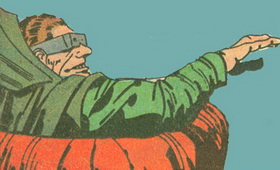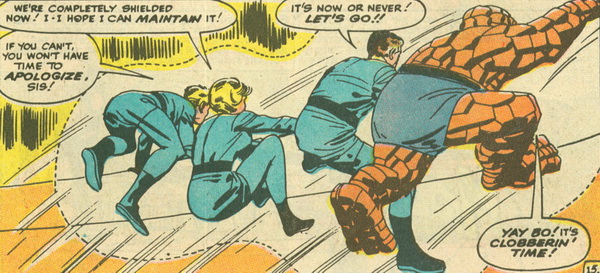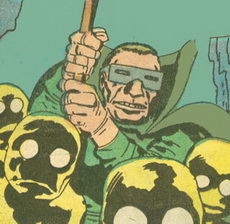
Published: January, 1964
Script: Stan Lee
Pencils: Jack Kirby
Inks: George Bell
Letters: Sam Rosen
The big news this time around is that Sue discovers she has more powers than anyone originally suspected. Not only can she make herself invisible, but she can also make inanimate objects invisible. However, when she does this, she can’t be invisible at the same time. Still working the kinks out of the system, I guess. Russ won’t tell me if she ever gets to the point where she and the objects can all be invisible at the same time. And that’s okay. I don’t want to know. It was fun encountering this new development in the earliest pages of Fantastic Four #22, and I’m willing to wait to find out how it naturally unfolds.
But invisibility is not the end of Sue’s powers! Most exciting of all, she can now throw a protective force field not only around herself, but also around anyone or anything she desires. At first glance, this may seem a wimpy, passive, girly superpower, but don’t be fooled! Force fields can function as an offensive tactic as well. In this story, she throws her force field around the remote control to planetary destruction, effectively thwarting Mole Man’s evil plan. Pretty useful talent to have in a pinch, wouldn’t you say? In the Twilight series, once Bella becomes a vampire, she finds herself with a similar power, and it goes a long way towards helping out the gang. 
As Sue’s new powers are revealed, Reed is quick to remark, “You used to worry because you felt you didn’t contribute enough to our little team! Well, I now suspect you’re about to become the star member!” This strikes me as only a teensy bit less heavy-handed than the allusions to Abraham Lincoln’s mother in FF #11. But I’ll forgive. Obviously, Stan’s just trying to get the point across. Perhaps readers who doubt Sue’s value need to be hit over the head with Abraham Lincoln’s mother. At any rate, I hope these developments mean that Sue will finally have more to do than turn invisible and/or get kidnapped.
And, oh! One more thing: At one point, when no one else should be around, Sue mentions she can sense the presence of others. Yet another emerging power? Hmmm…sounds promising, but I’m guessing this is nothing more than that good ol’ tried and true comic book power: Women’s Intuition!!
MOLE MAN MAKES CLASSIC VILLAIN MISTAKES
Sue’s new powers are put to the test when the FF run into their old foe, the hideous subterranean Mole Man. Wait! you may well say. Wasn’t he disposed of in FF#1? Nope. Seems Mole Man escaped through a series of underground tunnels, and has been rebuilding the kingdom of Subterranea in hopes of one day destroying the surface dwellers AND exacting his terrible revenge upon the Fantastic Four.
And his plan works well…at first. He arranges for a series of complaints by neighbors, at the same time Willie Lumpkin delivers a pamphlet about land for sale, “real cheap,” off the coast of New Jersey. Reed puts all these conveniently placed pieces together in his mind and promptly falls for it. I’m a little disappointed that a smart guy like Reed Richards wouldn’t suspect foul play at this point.
 But more about Reed later.
But more about Reed later.
The FF head out in their U-Car and upon reaching the island, quickly find Mole Man ruling from an overstuffed armchair, more than willing to explain how he and his blindly loyal subjects have built huge hydraulic platforms under the world’s most powerful cities, with a plan to pull the cities down to the earth’s core. After this happens, Mole Man assumes the Russians and Americans will blame each other, and destroy everything in WW III.
MMMWWWAAHHAHAHAHAHA!!!
A pretty good plan, if you can pull it off. And perhaps Mole Man could have pulled it off, if he hadn’t made that one teensy error: inviting the Fantastic Four to the party.
Yes, I understand he’s a super-villain, with all the usual ego issues that come with the territory. Killing everyone on the planet is not rewarding enough, unless you can make your arch-enemies squirm while they watch you do it. Being bad is not its own reward–the super-villain must have an audience.
But there’s a problem with super-villains, and Mole Man more than fits the profile. He resorts to a life of super-villiandom based on a long history of being shunned and ridiculed by the general population, so in a desperate effort to quell his ingrained inferiority complex, he strives to do everything on the most grandiose scale imaginable. Surely now they’ll all be sorry—but even more importantly, they’ll all be impressed.
So, against reason, Mole Man lures the Fantastic Four to his lair, conveniently forgetting that the last time they met, he barely escaped with his life. Perhaps he believes he learned something from that experience, and this time he’ll be able to deal with them.
Of course, he’s wrong. Not only are the FF brimming over with their usual ingenuity and resolve, but the formerly least imposing member of the team has now developed these wonderful new superpowers (just in the nick of time) which not only prevent Mole Man from flipping the switch on his planned disaster, but also provide a means of escape from the radioactive pit he’s thrown them into.

But never fear, Mole Man fans! After Sue escorts her team members out of the pit via her handy-dandy force field, they all immediately fall through panels in the floor, each to face a further trial at the hands of the conniving villain.
You have to give Mole Man props for devising this second layer of capture for his foes–“just in case.” But again, he exhibits a tremendous lack of judgment, by not devising yet a third layer. Not that it would make a difference, because clearly, no matter what trial he puts before the fantastic foursome, they will always overcome any odds.
I guess they haven’t been getting the latest issues of the Fantastic Four comic mag down there in Subterranea.
Briefly, Mole Man toys with Sue, giving her a mere thirty seconds to find her way out of her prison before it fills with noxious gas. He never imagines that this girl’s newly-honed ability to reveal invisible objects will show her the way out, and so he doesn’t bother to lock the door! The moral of this story: never underestimate the power of a woman…especially a woman with super-powers!
But Mole Man underestimates every one of his enemies. A wise, less egotistical villain–if such a thing could possibly exist–would have prioritized his objectives and worked on one thing at a time. Dispose of the surface-dwellers? Check! Build hydraulic lifts, push a button, and wait for WW III? Done! Show up the Fantastic Four? No problem!
 Or…is it? Radioactive pit, trick panels in the floor, diabolical prison cells… I can’t help thinking that if Mole Man hadn’t been so busy messing around with hydraulic lifts intended for mass destruction, he might have had time to work out that third layer of challenge for his mortal enemies—or at least had enough time to lock the door!
Or…is it? Radioactive pit, trick panels in the floor, diabolical prison cells… I can’t help thinking that if Mole Man hadn’t been so busy messing around with hydraulic lifts intended for mass destruction, he might have had time to work out that third layer of challenge for his mortal enemies—or at least had enough time to lock the door!
Though, as I’ve mentioned, it wouldn’t have done him any good.
The specter of the multi-tasking super-villain leads me to ask this all important question: what is Mole Man’s agenda…really? If he could destroy only one thing, which would it be: the entire surface world…or the Fantastic Four?
I think we all know the answer to that one.
And, in my opinion, that is why Mole Man will never be a successful super-villain.
TRUST AND OBEY
 In other news, this story also gives us a good look at the inner workings of the four, and how they operate as a unit. We always see how each of them employs their particular superpower to meet the need of the moment, but in this story, even as Sue shows a brief glimpse of Women’s Intuition, Reed’s Leadership Ability also shines.
In other news, this story also gives us a good look at the inner workings of the four, and how they operate as a unit. We always see how each of them employs their particular superpower to meet the need of the moment, but in this story, even as Sue shows a brief glimpse of Women’s Intuition, Reed’s Leadership Ability also shines.
Early in the story, when the four are trapped in the radioactive pit, a “so grim” Reed announces that he’s taking over. Like he doesn’t always take over? This time, though, he’s not kidding around. Reed commands Sue to create a force field around them. When Johnny doubts what good that could possibly do, Ben chimes in with, “If ol’ brain wave says do it, DO IT!” And in fact, that’s exactly what gets them out of their predicament, as they scale the radioactive walls under the protection of Sue’s force field.
Again, at the end of the story, just as all appears lost for planet Earth, Reed commands everyone to get in the U-Car ASAP. For a moment, it seems he’s only interested in saving their own skins, and to hell with New York and Moscow! So quickly forgetting his earlier support of the Boss Man, Thing complains, “Some leader you are! Chickenin’ out at the last minute! Phooey!”
Of course, Reed would never be so cowardly. It’s simply that he doesn’t have time to explain that he crossed the wires on Mole Man’s electronic control, and now a simple push of that button destroys not the bastions of surface world power (Moscow and Washing–oops, I mean, New York), but rather all of Mole Man’s underground kingdom.
Oh, the poetic justice!
Reed, I never doubted you for one moment. And the other members of your team shouldn’t have, either.
| Want to read this comic on your computer? Marvel has a scan! Want to own this story? Buy the Masterworks! |















Sue’s original power of invisibility wasn’t, per se, weaker than that of her three partners. Its drawback was that it wasn’t as strong an offensive ability as super-strength or flame or the ability to elongate. Its value was in clandestine operations, which generally weren’t the Fantastic Four’s stock-in-trade. Therefore, there were few occasions to showcase its importance.
Nevertheless, expanding Sue’s repertoire of powers was almost a necessity. It wouldn’t take long for a veteran FF foe like Doctor Doom to figure out ways to circumvent her invisibility—infra-red scanners, amplified-sound monitors, motion sensors, and the like—which would neutralise her invisibility. (Given the available technology in the twentieth century for thwarting an unseen foe, I’ve always wondered how Invisible Kid, of the Legion of Super-Heroes, ever served a practical purpose. One would figure that, by the thirtieth century, devices to stymie an invisible intruder would be as common and standard as deadbolt locks on doors are now.) Sue had to bring more to the table to keep her viable as a super-heroine.
It would take awhile, but eventually Sue’s ability to cast force-fields would become her primary power—especially after Lee and subsequent writers found more novel uses for it—to the point where, ten years down the road, a reader jumping into the series couldn’t be blamed for wondering why she was called the Invisible Girl.
But the most fun, I think, and I suspect you’ll discover, lied in the novel uses of Sue’s collateral invisibility powers. The ability to turn visible objects invisible has quite a few handy benefits. And the power to turn invisible things visible has considerable offensive benefit in a fight, if one stops to think through all the ramifications.
As Sue’s force-field powers were developed, these subsidiary abilities tended to be ignored. That’s why it was always a fun surprise when a writer remembered them and showed Sue using them in dynamic fashion. ( I can think of a couple of specific instances now, but it would push the spoiler-envelope a bit too much to cite them.)
P.S.
I see you added my Deck Log column to your blogroll. That’s a high compliment, and I take it very kindly. Thank you.
I do recall a couple of incidents thus far when Sue’s invisibility proved to be a great asset in getting the others out of a pickle, but you’re right—any super-villain worth his mettle may quickly figure out how to neutralize that. I like that she’s now more powerful than she’s been, and I look forward to her showing off her powers to their full extent. It’s good to know there will be more “dynamic” Sue scenes in my future!